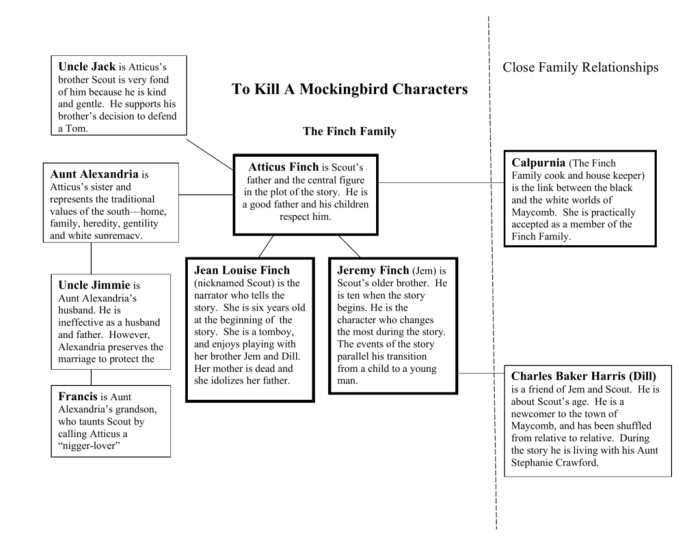To Kill a Mockingbird Character Chart: Embark on a literary journey to explore the intricate tapestry of characters that inhabit Harper Lee’s beloved masterpiece, “To Kill a Mockingbird.” This comprehensive guide delves into the personalities, motivations, and relationships of these unforgettable individuals, providing a deeper understanding of the novel’s timeless themes and profound impact.
Through detailed character profiles, insightful analysis of character dynamics, and exploration of character development, symbolism, and archetypes, this chart offers a multifaceted perspective on the characters that have captivated readers for generations.
Character Profiles: To Kill A Mockingbird Character Chart

The characters in To Kill a Mockingbirdare complex and well-developed, each playing a vital role in the novel’s plot and themes. The following table provides a detailed description of each character’s personality, motivations, and relationships:
| Name | Role | Key Traits | Notable Quotes |
|---|---|---|---|
| Atticus Finch | Lawyer and father of Scout and Jem | Intelligent, compassionate, and just | “You never really understand a person until you consider things from his point of view… Until you climb into his skin and walk around in it.” |
| Scout Finch | Atticus’s daughter and narrator of the novel | Curious, intelligent, and tomboyish | “I’m not a girl, I’m a tomboy.” |
| Jem Finch | Atticus’s son and Scout’s older brother | Adventurous, protective, and loyal | “I reckon if I never knew any better, I’d think this was the way things should be.” |
| Boo Radley | The mysterious neighbor of the Finches | Lonely, misunderstood, and kind | “You never really understand a person until you consider things from his point of view… Until you climb into his skin and walk around in it.” |
| Tom Robinson | A black man falsely accused of raping a white woman | Innocent, hardworking, and dignified | “I ain’t never seen no white man that could stand up to my old man in a stompin’ match.” |
| Mayella Ewell | The white woman who accuses Tom Robinson of rape | Poor, bitter, and vindictive | “I got somethin’ to say, and I ain’t gonna say it no more.” |
| Bob Ewell | Mayella’s father and a racist and abusive man | Vindictive, cruel, and violent | “I’m gonna kill that n* if he’s the last n* in Alabama.” |
| Miss Maudie Atkinson | The Finches’ neighbor and a wise and compassionate woman | Intelligent, tolerant, and independent | “The one thing that doesn’t abide by majority rule is a person’s conscience.” |
Character Dynamics

The relationships between the characters in To Kill a Mockingbirdare complex and nuanced. The following bullet points analyze some of the key relationships and discuss how they contribute to the overall plot and themes of the novel:
- Atticus and Scout:Atticus is a loving and supportive father who teaches Scout the importance of compassion, justice, and equality. Their relationship is a source of strength and guidance for Scout throughout the novel.
- Scout and Jem:Scout and Jem are close siblings who share a strong bond. They support each other through the challenges they face, and they learn to see the world from each other’s perspectives.
- Boo Radley and the Finches:Boo Radley is a mysterious and misunderstood neighbor who becomes a friend to Scout and Jem. His kindness and compassion challenge their preconceived notions about people.
- Tom Robinson and the Finches:Tom Robinson is a black man who is falsely accused of raping a white woman. Atticus defends Tom in court, but he is ultimately convicted by a racist jury. Tom’s case highlights the injustice and racism that exist in the American South.
- Bob Ewell and the Finches:Bob Ewell is a racist and abusive man who threatens the Finches after Atticus defends Tom Robinson. Ewell’s hatred and violence symbolize the dangers of racism and prejudice.
FAQ Insights
What is the significance of Boo Radley in “To Kill a Mockingbird”?
Boo Radley represents the themes of prejudice, fear, and the power of empathy. Despite being misunderstood and feared by the community, Boo’s actions reveal his true nature as a kind and compassionate individual.
How does Scout Finch’s character develop throughout the novel?
Scout undergoes significant growth and transformation throughout the novel. Initially a tomboyish and outspoken child, she gradually develops a deeper understanding of the complexities of society and the importance of empathy.
What is the role of Atticus Finch as a character archetype?
Atticus Finch embodies the archetype of the moral compass. He represents the values of integrity, justice, and compassion, serving as a role model for both Scout and the reader.


